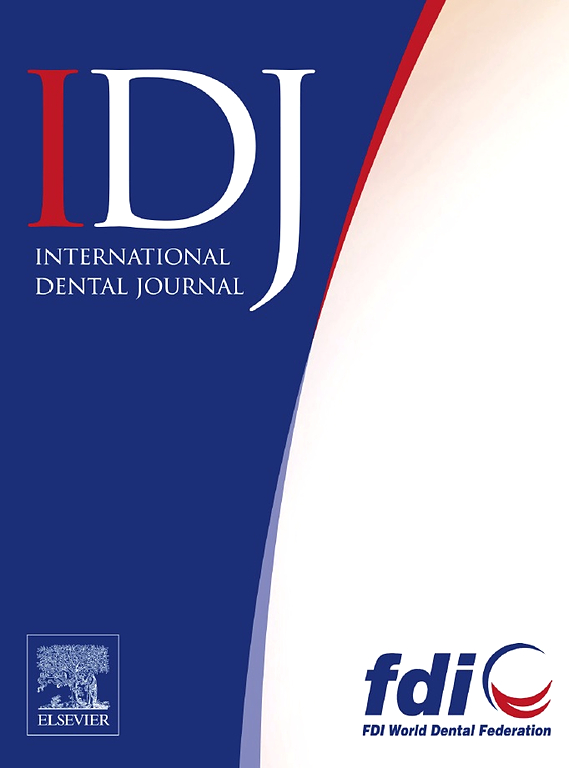Mucoperiosteal Flap Healing During Vertical Bone Augmentation using Titanium Mesh: A Study in Beagle Dogs
IF 3.2
3区 医学
Q1 DENTISTRY, ORAL SURGERY & MEDICINE
引用次数: 0
Abstract
Introduction and aims
The periosteal releasing incision (PRI) is often used in guided bone regeneration (GBR) with titanium (Ti) mesh to reduce the tension of mucoperiosteal flaps (MPF) and close the wound, but it can easily lead to keratinized gingiva (KG) narrowing and a high wound dehiscence rate. Therefore, it is necessary to explore alternative methods such as open healing. The aim of this study was to observe whether a MPF without a PRI and primary closure could heal on a titanium membrane surface in vertical bone augmentation and to measure the change in KG width.
Methods
The bilateral mandibular second, third, and fourth premolars and first molars were extracted from 6 beagle dogs. After 3 months, 4 sites were prepared on each side of the mandible to perform vertical bone augmentation and divided into 4 groups using a randomized block design. Group A: Bio-oss + Ti-membrane + Bio-gide + PRI and closing MPF; Group B: Bio-oss + Ti-membrane + Bio-oss + Bio-gide + PRI and closing MPF; Group C: Bio-oss + Ti-membrane + Bio-oss + Bio-gide + no PRI and unclosing MPF; and Group D: Ti-membrane + Bio-gide + no PRI and closing MPF. The study parameters were wound healing rate and dehiscence rate, KG widths, histologic analysis of gingiva, and analysis of the Ti-membranes surface.
Results
The wound dehiscence rates in groups A, B, and D were 50%, 41.67%, and 8.3%, respectively, and there was no statistical difference between group A and group B (P = 1.000). And in group C, only 1 wound exhibited incomplete soft-tissue closure of the gum (8.3%). The KG width in group C increased by 1.77 ± 0.37 mm, while the KG width in group B decreased by 4.37 ± 0.45 mm, and there was a significantly statistical difference between the 2 groups (P < .001). Compared to group B, the new gingiva in group C had better histological performance.
Conclusion
An MPF without PRI and primary closure can heal on the clean surface of the Ti membrane during vertical bone augmentation, and the KG can widen.
Clinical Relevance
The results have implications for the postoperative wound management of GBR supported by a titanium membrane.
比格犬垂直骨增强术中钛网黏膜瓣愈合的研究
前言与目的在钛网引导骨再生(GBR)中,常采用骨膜释放切口(PRI)来降低粘骨膜瓣(MPF)的张力,闭合创面,但其易导致角化龈(KG)狭窄,创面开裂率高。因此,有必要探索开放式治疗等替代方法。本研究的目的是观察没有PRI和初级闭合的MPF在垂直骨增强中是否可以在钛膜表面愈合,并测量KG宽度的变化。方法对6只beagle犬进行双侧下颌第二、第三、第四前磨牙和第一磨牙的拔除。3个月后,在下颌骨两侧各准备4个部位进行垂直骨增强,采用随机区组设计分为4组。A组:Bio-oss + Ti-membrane + Bio-gide + PRI和闭合MPF;B组:Bio-oss + Ti-membrane + Bio-oss + Bio-gide + PRI和闭合MPF;C组:Bio-oss + Ti-membrane + Bio-oss + Bio-gide + no PRI and unclosed MPF;D组:ti膜+ Bio-gide +无PRI和封闭MPF。研究参数为创面愈合率、裂开率、KG宽度、牙龈组织学分析、ti膜表面分析。结果A、B、D组创面裂开率分别为50%、41.67%、8.3%,A组与B组比较差异无统计学意义(P = 1.000)。C组只有1例牙龈软组织闭合不全(8.3%)。C组KG宽度增加1.77±0.37 mm, B组KG宽度减少4.37±0.45 mm,两组比较差异有统计学意义(P <;措施)。与B组相比,C组新生牙龈的组织学表现更好。结论在垂直骨增强术中,不带PRI和一期闭合的MPF可在钛膜清洁表面愈合,KG可增宽。临床意义本研究结果对钛膜支撑GBR的术后创面处理具有指导意义。
本文章由计算机程序翻译,如有差异,请以英文原文为准。
求助全文
约1分钟内获得全文
求助全文
来源期刊

International dental journal
医学-牙科与口腔外科
CiteScore
4.80
自引率
6.10%
发文量
159
审稿时长
63 days
期刊介绍:
The International Dental Journal features peer-reviewed, scientific articles relevant to international oral health issues, as well as practical, informative articles aimed at clinicians.
 求助内容:
求助内容: 应助结果提醒方式:
应助结果提醒方式:


